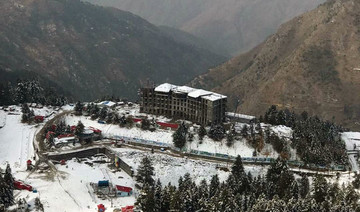CHIANG MAI: Young boys walk in pairs late in the evening at Chiang Mai's popular Tha Phae Gate, sauntering past tourists taking photos of the fort as locals hawk souvenirs.
No one would connect the boys to the older, white men - and a pair of Chinese 40-somethings - seated under a tree, or to the young man with the mobile phone leaning on a parked motorbike.
But for Alezandra Russell, founder of non-profit Urban Light, this scene - which unfolds every evening in one of the country's most popular tourist spots - sums up everything that is wrong with Thailand's approach to trafficking and slavery.
"The dialogue in Thailand - and around the world - is focused on women and girls, because the general perception is that boys are big and strong, and that they can take care of themselves," said Russell, pointing out the deals being done.
The boys, aged from 14 to 24, walk in pairs for greater safety, making eye contact with the men, who then communicate their choices to the man with the mobile phone. Once the deal is done, the boys move to a side alley to wait for their clients.
If no one passes muster, the men head to one of dozens of bars and karaoke lounges that offer boys for sex. The rates range from 2,000 baht ($62) for an hour to 5,000 baht for longer, in a back room or in the client's hotel, Russell said.
"Why does this not shock and enrage people as much as it does when it's girls?" said Russell, whose drop-in centre is for boys in Chiang Mai's sex industry.
"They are no less vulnerable and abused than girls who are trafficked into sex work. Yet it is much more hidden, so there's much less sympathy, and far fewer resources for boys," she said.
SOAPY MASSAGE
Thailand is a source, transit, and destination country for children trafficked for sexual exploitation.
Thailand has more than 123,530 sex workers, according to a 2014 UNAIDS report. Of these, at least 40 percent are under 18, and a significant number are boys, according to rights groups.
Children are trafficked into Thailand from Cambodia, Laos, Myanmar and Vietnam. Victims from Bangladesh, Pakistan, North Korea and China also transit through Thailand en route to the United States, western Europe and Russia, activists say.
"We are aware that there are boys also in the sex trade," said Krittat Uamson, deputy director of the justice ministry's human trafficking division in Bangkok. "But the majority of sex workers is girls and women, so our main focus is women."
Globally, as many as 2 million children are sexually exploited annually, according to the United Nations children's agency UNICEF. A significant number are boys, campaigners say.
Boys in poorer countries are particularly vulnerable, as they are often forced to work to support their families, and end up being lured to popular tourist spots.
Thailand's sandy beaches, gilded Buddhist temples and popular cuisine drew a record 35 million visitors in 2017, with that number expected to rise to nearly 38 million this year, according to government data.
Although prostitution is illegal, it is tolerated.
Go-go bars, karaoke lounges and parlours offering "soapy massages" - bubble baths that usually end with sex - can be found in most cities and beach towns such as Phuket and Pattaya.
Agents prey on boys at bus stations, or go to villages to recruit them. The boys quickly run up debts with bar owners for clothes, drugs and money sent to their families, forcing them to remain in the bars, Russell said.
STIGMA
Violence and abuse are common, as is substance abuse and sexually-transmitted infections including HIV and AIDS, according to a 2013 study on boys in Chiang Mai's sex industry.
The boys also display self-harming and suicidal tendencies, said Russell, who pawned her engagement and wedding rings to set up Urban Light.
"They are exposed to so much abuse and violence: I have seen boys come in who cannot even sit down. No 15-year-old should go through that," she said.
"But we shouldn't focus just on getting boys off the street. We have to involve the families, the communities that are putting them at risk, and talk about child rights, and safe migration," she told the Thomson Reuters Foundation.
A 2016 Global Slavery Index, compiled by the Walk Free Foundation, estimates that 425,500 people live in conditions of modern slavery - including sexual slavery - in Thailand.
To clean up the country's image, the government recently partnered with airlines and charities to warn visitors about trafficking, urging them to report suspected cases.
It also runs vocational training for at-risk young people, and operates 24-hour hotlines, said Krittat.
But most of these efforts are focused on girls and women, leaving boys and young men vulnerable, activists say.
"There is greater stigma around sexual abuse of boys in some cultures, including in Thailand," said Damian Kean at ECPAT International, a network of non-profits working to end sexual exploitation of children.
"Anecdotal evidence shows it's under-reported to a far greater degree than sexual abuse of girls. And the offenders are not just Western tourists, but are just as likely to be locals and other Asian men," he said.
Children worldwide are more likely to be preyed upon by residents of their own homeland than foreign tourists seeking illicit sex, anti-trafficking experts say.
TUK-TUK
Last year, Urban Light worked with more than 1,000 boys in Chiang Mai, which Russell said was a record.
Poverty drives thousands in rural Thailand and from neighbouring countries to the bustling capital of Bangkok, too.
Boys and so-called "ladyboys", or transgender women, are trafficked to the city, lured by promises of jobs in restaurants, then forced into sex work.
There are at least 10,000 ladyboys working in Bangkok's sex industry, said Celeste McGee, founder of Dton Naam, a charity that focuses on boys and transgender women.
"There is more stigma around transgender women than even homosexual men," said McGee.
"They are exposed to a lot of violence and abuse from clients, and need different interventions for rehabilitation."
Urban Light and Dton Naam offer counselling, vocational guidance, funds to complete school, and job opportunities.
In Chiang Mai, many drive tuk-tuks with the help of loans or grants, Russell said.
One of them, who goes by the name Joe, entered the trade when he was 15 years old, and worked for seven years, contracting HIV along the way.
Today, he drives a tuk-tuk, his girlfriend sometimes accompanying him, with an Urban Light sticker that says 'Boys cannot be baht' displayed prominently on the vehicle.
"I like this job, and being my own master," he said. "This makes me feel happy, confident."
Pakistani children among others trafficked to Thailand for sex work
Pakistani children among others trafficked to Thailand for sex work
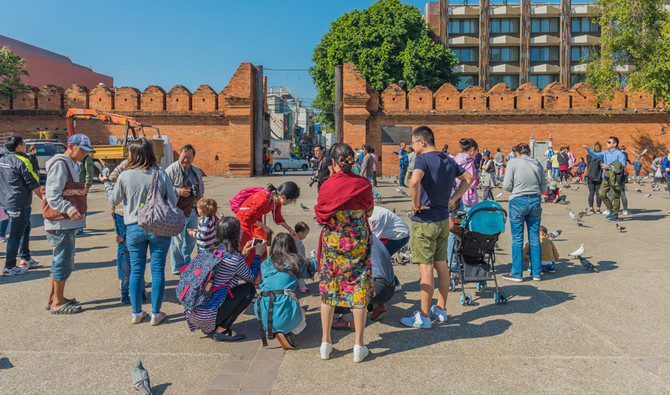
- Thailand is a source, transit, and destination country for children trafficked for sexual exploitation
- Poverty drives thousands in rural Thailand and from neighbouring countries to the bustling capital of Bangkok, too
Two Saudi hotels listed in Conde Nast’s Hot List of new openings from the last year
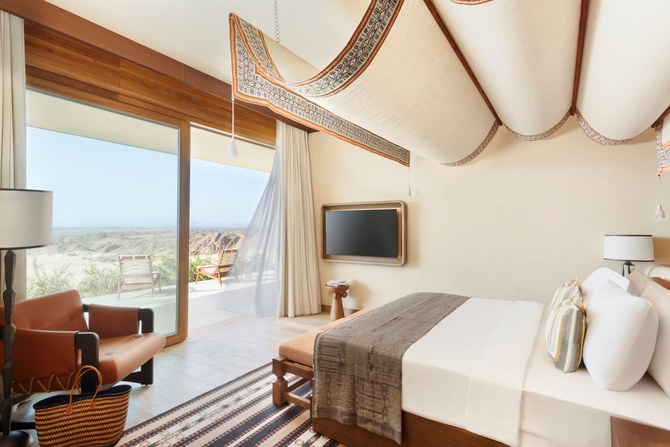
DUBAI: For those planning their next staycation, two hotels in Saudi Arabia have found a spot in Conde Nast’s prestigious annual Hot List, with one of them located in the heart of Riyadh.
The St Regis Riyadh and Six Senses Southern Dunes, The Red Sea have joined the list of best hotel openings from the last year, spanning the globe, from Argentina and Zimbabwe to Nepal and Spain, and more.
The St Regis Riyadh is “the only hotel inside Via Riyadh – a bijou mall of designer boutiques, hand-picked restaurants, and a cinema complex, wrapped within monumental sandstone walls at the edge of the Saudi capital’s Diplomatic Quarter – the St Regis Riyadh nods to the hotel brand’s New York heritage as well as its new Saudi home,” according to the publication.

Meanwhile, the new Six Senses Southern Dunes, The Red Sea, is the first resort to open in the 28,000-square-kilometer expanse of sea, reefs, islands and inland desert known, simply, as The Red Sea. It’s one of Saudi Arabia’s ambitious tourism-focused giga-projects, part of the Kingdom’s Vision 2030 aimed at diversifying the economy and heralding a new future for the nation.
Moroccan director Asmae El-Moudir joins Cannes’ Un Certain Regard jury
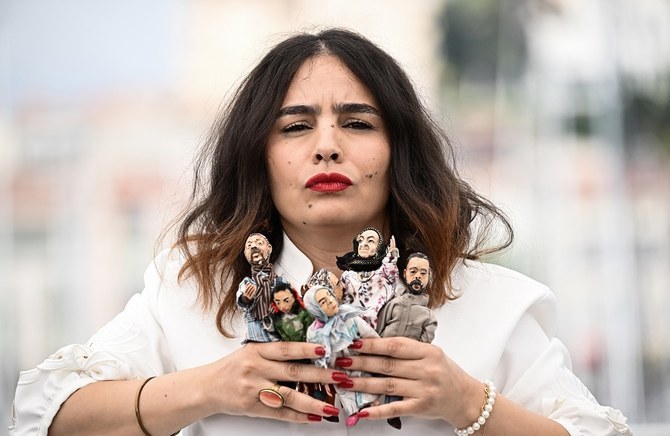
DUBAI: The Cannes Film Festival announced on Thursday that Moroccan director, screenwriter and producer Asmae El-Moudir will be part of the Un Certain Regard jury at the 77th edition of the event, set to take place from May 14-25.
She will be joined by French Senegalese screenwriter and director Maïmouna Doucouré, German Luxembourg actress Vicky Krieps and American film critic, director, and writer Todd McCarthy.
Xavier Dolan will be the president of the Un Certain Regard jury.
The team will oversee the awarding of prizes for the Un Certain Regard section, which highlights art and discovery films by emerging auteurs, from a selection of 18 works, including eight debut films.
El-Moudir is the director of the critically acclaimed film “The Mother of All Lies.”
The movie took the honors in the Un Certain Regard section, as well as winning the prestigious L’oeil d’Or prize for best documentary at the festival in 2023. The film explores El-Moudir’s personal journey, unraveling the mysteries of her family’s history against the backdrop of the 1981 bread riots in Casablanca.
El-Moudir is not the only Arab joining the Cannes team.
Moroccan Belgian actress Lubna Azabal this week was appointed the president of the Short Film and La Cinef Jury of the festival. The La Cinef prizes are the festival’s selection dedicated to film schools.
Second Ritz-Carlton Reserve in Saudi Arabia planned for Neom
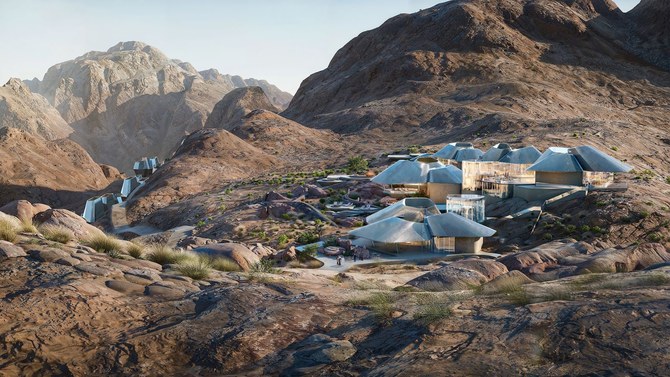
DUBAI: Marriott International, Inc. announced on Thursday that it has signed an agreement with Neom to open its second Ritz-Carlton Reserve in Saudi Arabia.
The hotel is anticipated to open in Trojena, a year-round mountain destination located in the northwest region of the country.
The resort is expected to feature 60 expansive one-to-four-bedroom villas. Plans also include a range of amenities including a spa, swimming pools and multiple culinary venues.
Chadi Hauch, the regional vice president of Lodging Development Middle East, Marriott International said in a statement: “Together with Neom, we look forward to bringing this ultra-luxury experience to Trojena. This signing also marks an important addition to our portfolio in Saudi Arabia where we continue to see a strong demand for our luxury brands.”
“Trojena is a rare destination, and we are delighted that Ritz-Carlton Reserve has hand-picked the mountains of Neom for their next property. Together we will create an experience that can’t be recreated anywhere else. Our visitors and residents will experience a sanctuary that will capture the magic of Saudi Arabia, embracing ultimate luxury in an unforgettable location,” executive director and Trojena region head Philip Gullett said in a statement.
Trojena, one of the flagship developments within Neom, is being developed and positioned as a year-round adventure sports destination that will include activities such as skiing, water sports, hiking and mountain biking. It will also include apartments, chalets, retail, dining, entertainment, leisure, sports and recreational facilities, and other hospitality offerings, including a W Hotel and a JW Marriott Hotel.
Ritz-Carlton Reserve currently boasts a collection of only six properties in destinations including Thailand, Indonesia, Puerto Rico and Mexico.
The Arab world at the Venice Biennale: Artists explore themes of identity, immigration, history
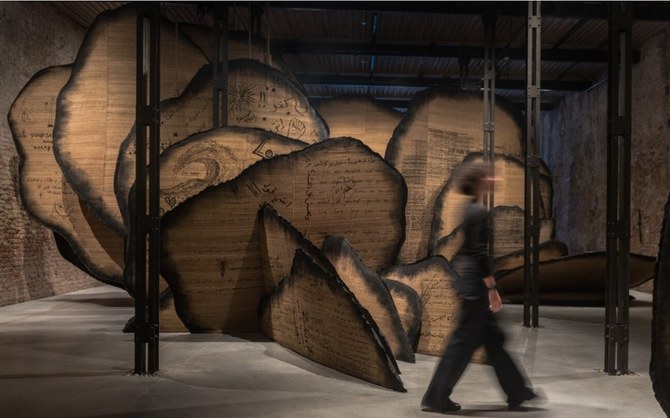
VENICE: No event in the international art scene is more anticipated, or debated, than the Venice Biennale. This year’s edition, “Foreigners Everywhere,” curated by Adriano Pedroso from Brazil, features 331 artists and 86 nations, including four Gulf countries as well as Lebanon and Egypt.
Saudi Arabia
Women’s voices chanting in unison fill the air of the Saudi Pavilion at Venice this year. “Shifting Sands: A Battle Song” was created by Saudi artist Manal AlDowayan, and hundreds of women from across the Kingdom participated in its creation. The exhibition, which includes large-scale installations in the form of desert roses filled with writing and drawings by the Saudi female participants whom AlDowayan worked with, aims to showcase the evolving role of women in the Kingdom while also striving to dispel media narratives that have long defined them. The chanting is derived from traditional battle songs once performed by Saudi men before they went into battle. Here they are chanted by women in a powerful chorus of strength and resilience, backed by recordings of the wind passing through sand dunes. The work, AlDowayan tells Arab News, “is about change, subtle changes — like those of a sand dune — the surface changes, but the core stays the same.”

UAE
Emirati artist Abdullah Al-Saadi is presenting “Sites of Memory, Sites of Amnesia” at the National Pavilion of the United Arab Emirates. It’s an introspective show consisting of drawings, sculptures, paintings and installations charting Al-Saadi’s travels around his homeland. “Traveling and understanding the natural world around me has always been an important part of my work,” Al-Saadi, who has even used rocks from the Emirates as his ‘canvas’ for some of the works, told Arab News. “Through this presentation in Venice, I hope visitors will enjoy tracing the travels I have taken over the past few years and also think about the world around us, and our place within it.”
Visitors will also be presented with gifts: maps and scrolls in colorful traditional chests from the region, which will be removed and presented to guests by actors from the UAE.
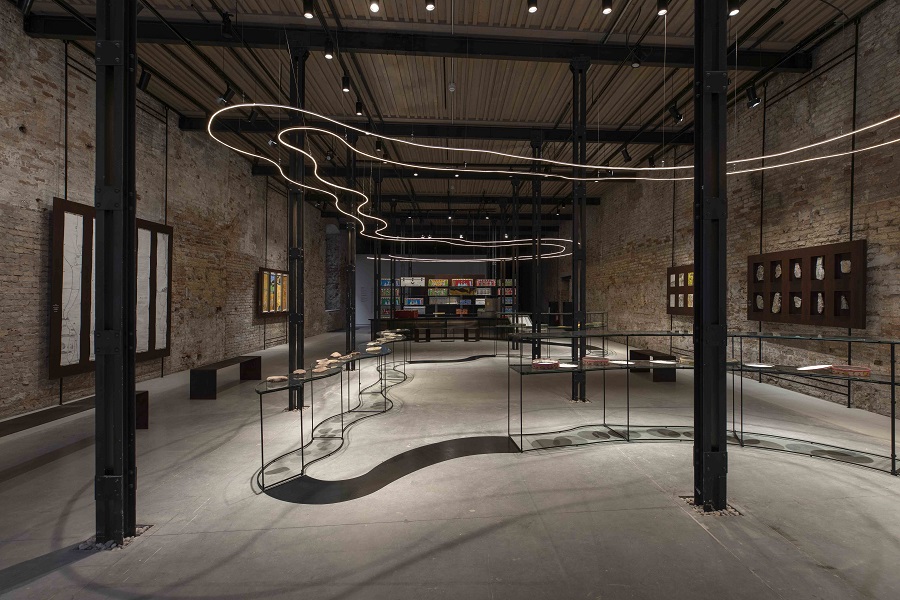
Qatar
While Qatar doesn’t have a national pavilion at the biennale, it is presenting “Your Ghosts Are Mine: Expanded Cinemas, Amplified Voices” — a group show of films by artists from across the Arab world, Africa and South Asia, as well as video installations from the collections of Mathaf: Arab Museum of Modern Art and the Art Mill Museum (scheduled to open in 2030). All the films were backed by the Doha Film Institute.
“For me, it was important to show movies reflective of the theme of the biennale — so, revolving around immigration, foreigners, personal diaries and self-portraits and stories from women — all coming from independent (artists) in the Global South, whose voices are not always shared,” the Paris-based curator Matthieu Orlean told Arab News.
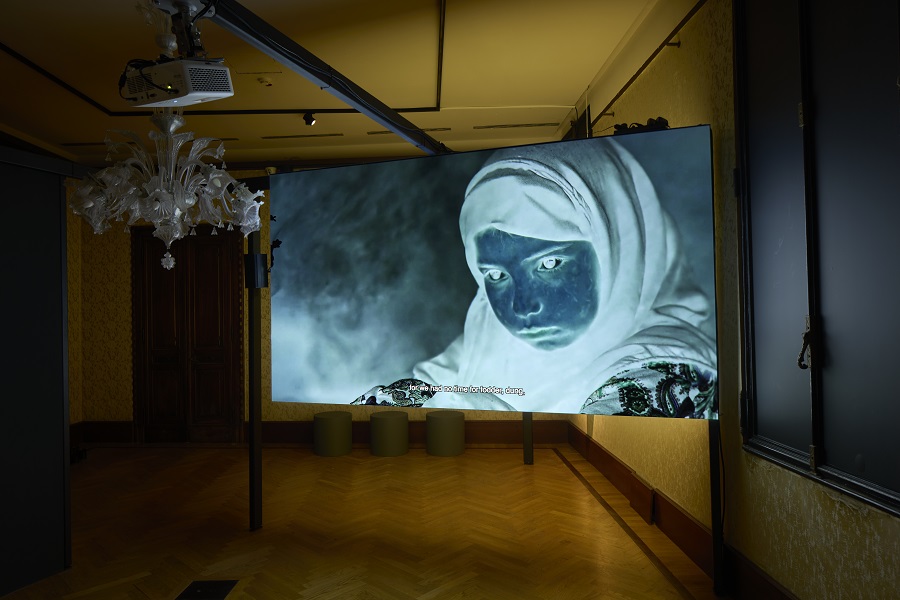
Egypt
Alexandrian-born artist Wael Shawky has created “Drama 1882,” a 45-minute film for which he also composed the music, for Egypt’s national pavilion, which — in the first week of the biennale at least — has proved to be one of the most popular pavilions at this year’s event.
The film is based around Egypt’s nationalist Urabi revolution against imperial influence in the late 19th century and Shawky uses historical and literary references as starting points from which to weave together a story that fuses fact, fiction and fable, while also exploring national, religious and artistic identity.
“I worked with performers who enacted a play in a theater for the film,” Shawky told Arab News. “The film strives in part to connect the idea of history to drama — drama regarding the connection to catastrophe and drama regarding cynicism. I like to analyze the authenticity of history, especially Egyptian history. When one makes films about history there is this gap between truth and myth.”

Lebanon
Lebanese artist Mounira Al-Solh’s multimedia installation “A Dance with Her Myth” combines drawing, painting, sculpture, embroidery, video, and audio, and guides viewers through ancient Phoenicia. The piece, Al-Solh explains to Arab News, is inspired by the tale of Europa, the daughter of a Phoenician king who was abducted from the city of Tyre in Lebanon by the Greek god Zeus, who had transformed himself into a white bull to trick her into riding him, then took her off into the sea.
“The (work) pays tribute to the ancient multicultural heritage of Lebanon,” Al-Solh says.
In the center of the pavilion is an unfinished boat, that Al-Solh says references “the tension that women still face today, despite their emancipation.”
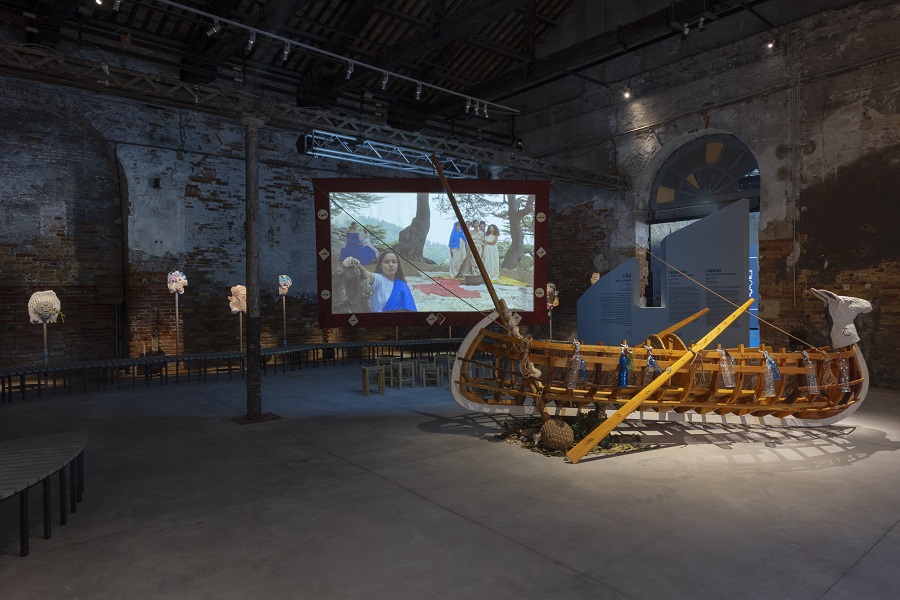
Oman
Oman’s second participation in the biennale, is an exhibition titled “Malath — Haven.” It includes work from five Omani contemporary artists: Ali Al-Jabri, Essa Al-Mufarji, Sarah Al-Aulaqi, Adham Al-Farsi and Alia Al-Farsi (who also curated the show). “We used the word ‘haven’ in the title because, since antiquity, foreigners — including the Romans, Portuguese and Indians — have visited Oman,” Alia Al-Farsi told Arab News. The works on display — from Al-Farsi’s own colorful and expressive mixed-media murals (such as “Alia’s Alleys,” pictured here) to Al-Aulaqi’s “Breaking Bread,” which includes a large sculpture of a niqab made from silver spoons — reflect both traditional and contemporary life in Oman.
“As an Omani creative with an international background, my aim was for the exhibition to serve as a sanctuary for visitors and travelers, allowing stories to unfold and intertwine, mirroring how our country finds its richness in intercultural dialogue,” the curator said in a statement.
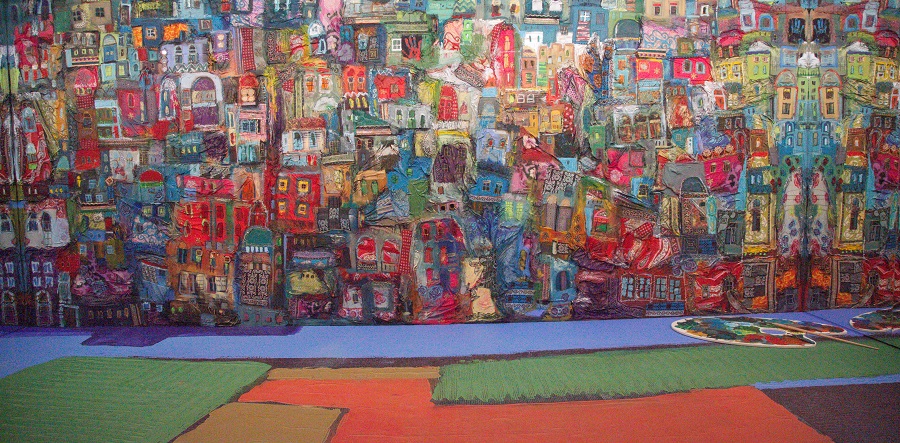
Behind the scenes at Mazen Laham’s Middle East media powerhouse
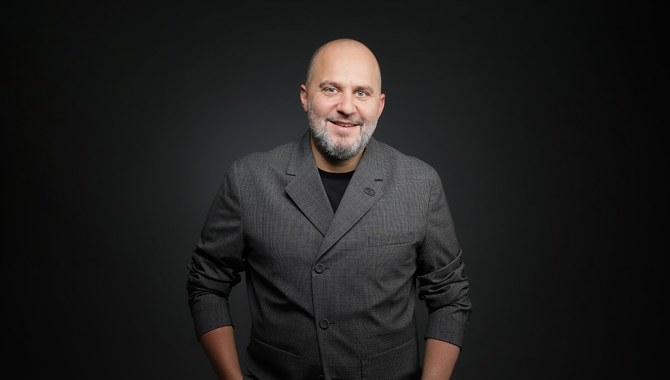
- Mazen Laham’s Different Productions, the company behind “Dubai Bling” and the regional version of “Shark Tank,” just celebrated its 10th anniversary
- Discussing Arabic-language adaptations of global shows, he said they preserve the original concept while respecting cultural sensitivities
DUBAI: Lebanese producer Mazen Laham’s Different Productions celebrated its 10th anniversary this month. The company is one of the driving forces of the television industry in the region, responsible for the creation of acclaimed shows including Netflix’s “Dubai Bling,” and “It’s OK” — a docuseries about the Lebanese pop superstar Elissa — as well as Arabic adaptations of popular franchises “Shark Tank,” “Say Yes to the Dress,” and “Chopped.”
Laham told Arab News that shooting for the third season of “Dubai Bling” has already concluded, adding that it is “even bigger than the two previous seasons.” He confirmed that Emirati-Egyptian TV host Mahira Abdeaziz and Iraqi influencer Jwana Karim will be joining the cast, which already includes Zeina Khoury, Safa and Fahad Siddiqui, DJ Bliss, Danya Mohammed, Kris and Brianna Fade, Mona Kattan Al-Amin, Hassan Al-Amin, Loujain Adada, Ebraheem Al-Samadi, and Farhana Bodi.
The previous two seasons both ranked in the global top 10 for non-English series on Netflix. “I believe in numbers,” Laham said. “It was (popular) globally. What I will say is that season three is a very big season.”
While they suspected the show would be popular, Laham admitted that he and his team were not expecting it to get quite so big. “What we were aiming for is to have a good show but we never thought that it will be this successful,” he said.
The show may be popular, but it has also attracted plenty of criticism online for its depiction of life in Dubai. Laham, though, seems unperturbed.
“We never said that this is Dubai. From day one, we said it is about a group of friends living in Dubai,” he said. “It is not a documentary about the city. We are not saying ‘This is Dubai and this is life in Dubai,’ we only focused on a group of friends living in Dubai.”
Discussing his company’s various Arabic-language adaptations of international shows, Laham said that they try to preserve the original concept of the show while ensuring they cater to the cultural sensitivities and preferences of the region.
“Before getting the shows, we make sure that they fit our culture — anything that, culturally, does not pass, we do not even get it in the first place,” he said. “But, whenever we see something that could be adapted, yes, we (try to) get the rights for it. The most important thing is to keep the structure and the main spirit of the format the same.”
Laham believes there are now two distinct audiences for shows: those for traditional television networks and those for streaming services such as Netflix, Shahid, Starzplay.
“What is on TV does not work on a platform and vice versa, because the new generation want something fast — they want something will keep them hooked. So, it’s very challenging to make content for them,” he said.
What Laham believes works best are docuseries such as “Dubai Bling” and “It’s OK.”
“These are non-scripted, but they are serialized; they’re sticky,” he explained. “You want to keep on watching to follow the stories and this is when you binge watch. On TV channels, you still get to see classical standalone episodes.”
Laham said Different Productions is currently working on an original docuseries for Starzplay called “Unstoppable.”
“It’s a football-based reality show where children between the ages of 13 and 15 compete. There will be one winner, and the winner will hopefully play for one of the big Italian teams,” he said.
Laham described the Saudi Arabia market as “promising,” not only due to the growing number of original productions but also because “the infrastructure, whether it’s Neom or AlUla,” is drawing in creatives from around the world. “I think it’s going to the biggest media hub out there very soon,” he added.
“We care a lot about the viewership in Saudi Arabia because it’s the biggest market,” Laham said. “So we always look into the ratings — even if it’s not a pure Saudi show, we want our shows to be watched in Saudi Arabia.”


